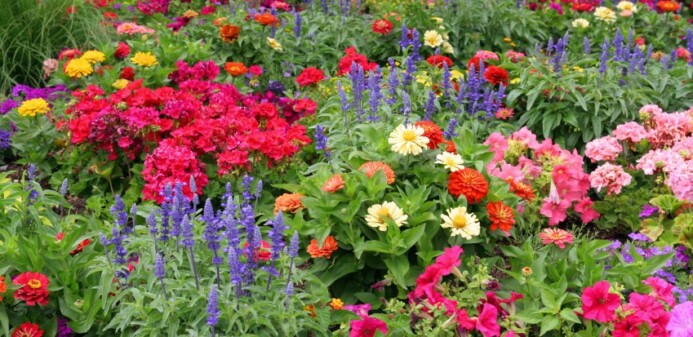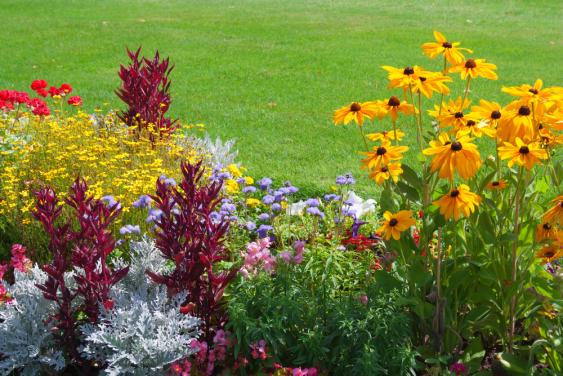Flower gardens are a fantastic way to boost curb appeal, great for pollinators, and give you that good feeling by providing a pop of color to your landscape. Don’t let another season pass while just dreaming about it. Here are 8 tips on designing and planting a new or revamping an older garden bed.
Prepare the Flower Bed
After choosing the location, remove excess vegetation loosen and enrich the soil by mixing in compost. This will give your annuals a great boost of nutrients and the loosened soil will be easier to work with.
Unless you already have a prepared bed to plant in, you’ll need to remove the grass by either digging it out, applying an herbicide or smother it with cardboard or newspaper. The latter method takes time and should be started months before planting. An herbicide is quick but prevents you from planting right away.
Think about Winter Interest
What will the space look like in the dead of winter? It’s nice to include an evergreen or plan to include a container with winter greens or choose a site around a small tree that will have structure.
Know Your Light Conditions
Keep your exposure in mind when selecting flowers. Are you dealing with full sun, full shade or something in between? The definition of full sun is six or more hours of direct sunlight per day. Ideally, the sun should be blasting straight down on the plants from 10:30 to 2:30 PM.

Diversify Bloom Color and Foliage
Colors play an important part of the design. Choose a color scheme that is appealing to you. Too many colors together can create chaos. Consider the foliage of their leaves (texture color, shape) because their leaves are what you are going to see also.
Whether you choose annuals or perennials, or a combination of both, overlap bloom times a little bit so there’s something in bloom all the time. For example, choose a late spring to mid-summer summer variety and then pick up a mid-summer to fall. Some annuals may bloom the whole summer.
Additional Reading: Best Tips on Planting Annuals for Great Summer Color
Plant Pollinator-Friendly Plants

A garden of annuals.
Enjoy watching bees, butterflies and hummingbirds move from one plant to another. Native plants have proven to be four times more attractive to pollinators than non-natives. To learn more about pollinators, read Pollinators 101.
Additional Resources
Native Perennials for a Sunny or Shady Pollinator Garden
Pollinator-Friendly Plants for the Northeast United States
Plant in Groupings of Three
If you want to create the best impact in a large area, plant in groupings of three. Single plants give too much empty space and more weeds to pull. Use the odd number formula for a more natural feel.
Layer the Heights
Shortest plants are in the front, medium next, and the tallest in the back or center. You’ll get to see each plant individually and no plant blocks another plant. If you have a site that you see from both sides, plant the taller plants in the middle.
Aftercare
Removing spent flower heads (dead-heading) generally extends blooming. Most perennials should be cut back in late winter or early spring once they brown up or are frost-killed.
Weed and deadhead flowers if needed. If you’re using annuals, use a special ‘bloom boosting’ fertilizer once a month to keep flowers thriving throughout the growing season. Newly planted beds will need to be watered well.
Choose Whitehouse Landscaping
Whitehouse Landscaping is a full service landscaping company and have been offering residential services to improve your property for over 20 years. If you’re interested in getting a quote, you can contact us online or give us a call at 484-300-4290.

